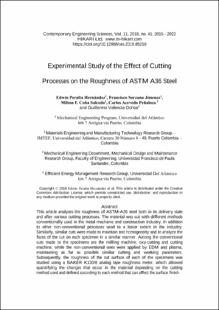Mostrar el registro sencillo del ítem
Experimental study of the effect of cutting processes on the roughness of ASTM A36 steel
| dc.contributor.author | Peralta Hernandez, Edwin | |
| dc.contributor.author | Sorzano Jimenez, Francisco | |
| dc.contributor.author | Coba Salcedo, Milton Fabian | |
| dc.contributor.author | Acevedo Peñaloza, Carlos Humberto | |
| dc.contributor.author | Valencia Ochoa, Guillermo | |
| dc.date.accessioned | 2021-12-12T23:08:53Z | |
| dc.date.available | 2021-12-12T23:08:53Z | |
| dc.date.issued | 2018-06-06 | |
| dc.identifier.uri | http://repositorio.ufps.edu.co/handle/ufps/6383 | |
| dc.description.abstract | This article analyses the roughness of ASTM-A36 steel both in its delivery state and after various cutting processes. The material was cut with different methods conventionally used in the metal-mechanic and construction industry, in addition to other non-conventional processes used to a lesser extent in the industry. Similarly, similar cuts were made to maintain test homogeneity and to analyze the faces of the cut on each specimen in a similar manner. Among the conventional cuts made to the specimens are the milling machine, oxy-cutting and cutting machine, while the non-conventional ones were applied by EDM and plasma, maintaining as far as possible similar cutting and working parameters. Subsequently, the roughness of the cut surface of each of the specimens was studied using a BAKER K130/8 analog tape roughness meter, which allowed quantifying the changes that occur in the material depending on the cutting method used and defined according to each method that can affect the surface finish and therefore the final application of the material. The graphical results allowed a comparative analysis of all the methods used, as well as the differences found between them and to obtain important conclusions that can be used in the new techniques of the manufacturing processes. | eng |
| dc.format.extent | 08 páginas | spa |
| dc.format.mimetype | application/pdf | spa |
| dc.language.iso | eng | spa |
| dc.publisher | Contemporary Engineering Sciences | spa |
| dc.relation.ispartof | Contemporary Engineering Sciences | |
| dc.rights | © 2018 Edwin Peralta Hernandez, Francisco Sorzano Jimenez, Milton F. Coba Salcedo, Carlos Acevedo Penaloza and Guillermo Valencia Ochoa. This article is distributed under the Creative Commons Attribution License, which permits unrestricted use, distribution, and reproduction in any medium, provided the original work is properly cited. | eng |
| dc.source | http://www.m-hikari.com/ces/ces2018/ces41-44-2018/85210.html | spa |
| dc.title | Experimental study of the effect of cutting processes on the roughness of ASTM A36 steel | eng |
| dc.type | Artículo de revista | spa |
| dcterms.references | S. Vajpayee, Analytical study of surface roughness in turning, Wear, 70 (1981), no. 2, 165–175. https://doi.org/10.1016/0043-1648(81)90151-4 | spa |
| dcterms.references | P. Patel, S. Soni, N. Kotkunde and N. Khanna, Study the effect of process parameters in plasma arc cutting on Quard-400 material using analysis of variance, Mater. Today Proc., 5 (2018), no. 2, 6023–6029. https://doi.org/10.1016/j.matpr.2017.12.206 | spa |
| dcterms.references | E. Tomanik, M. El Mansori, R. Souza and F. Profito, Effect of waviness and roughness on cylinder liner friction, Tribol. Int., 120 (2018), 547–555. https://doi.org/10.1016/j.triboint.2018.01.012 | spa |
| dcterms.references | D. Yang and Z. Liu, Surface topography analysis and cutting parameters optimization for peripheral milling titanium alloy Ti–6Al–4V, Int. J. Refract. Met. Hard Mater., 51 (2015), 192–200. https://doi.org/10.1016/j.ijrmhm.2015.04.001 | spa |
| dcterms.references | T. Pancewicz and I. Mruk, Holographic contouring for determination of three-dimensional description of surface roughness, Wear, 199 (1996), no. 1, 127–131. https://doi.org/10.1016/0043-1648(96)07229-8 | spa |
| dcterms.references | E. S. Gadelmawla, M. M. Koura, T. M. A. Maksoud, I. M. Elewa and H. H. Soliman, Roughness parameters, J. Mater. Process. Technol., 123 (2002), no. 1, 133–145. https://doi.org/10.1016/s0924-0136(02)00060-2 | spa |
| dcterms.references | C. L. He, W. J. Zong and J. J. Zhang, Influencing factors and theoretical modeling methods of surface roughness in turning process: State-of-the-art, Int. J. Mach. Tools Manuf., 129 (2018), 15–26. https://doi.org/10.1016/j.ijmachtools.2018.02.001 | spa |
| dcterms.references | N. L. Arrizabalaga, Máquinas: Prontuario : Técnicas, Máquinas, Herramientas, Paraninfo, 1997. | spa |
| dcterms.references | L. De Chiffre, P. Lonardo, H. Trumpold, D.A. Lucca, G. Goch, C.A. Brown, J. Raja, H.N. Hansen, Quantitative Characterisation of Surface Texture, CIRP Ann., 49 (2000), no. 2, 635–652. https://doi.org/10.1016/s0007-8506(07)63458-1 | spa |
| dcterms.references | ISO 25178-605, Geometrical product specifications (GPS) – Surface textute: Areal - Part 605: Nominal characteristics of non contact (point autofocus probe) instruments, 2014. https://doi.org/10.3403/30205377 | spa |
| dc.identifier.doi | https://doi.org/10.12988/ces.2018.85210 | |
| dc.publisher.place | Bulgaria | spa |
| dc.relation.citationedition | Vol.11 No.41.(2018) | spa |
| dc.relation.citationendpage | 2022 | spa |
| dc.relation.citationissue | 41(2018) | spa |
| dc.relation.citationstartpage | 2015 | spa |
| dc.relation.citationvolume | 11 | spa |
| dc.relation.cites | Hernández, E. P., Jímenez, F. S., Salcedo, M. F. C., Peñaloza, C. A., & Ochoa, G. V. (2018). Experimental Study of the Effect of Cutting Processes on the Roughness of ASTM A36 Steel. | |
| dc.relation.ispartofjournal | Contemporary Engineering Sciences | spa |
| dc.rights.accessrights | info:eu-repo/semantics/openAccess | spa |
| dc.rights.creativecommons | Atribución-NoComercial-SinDerivadas 4.0 Internacional (CC BY-NC-ND 4.0) | spa |
| dc.subject.proposal | Roughness | eng |
| dc.subject.proposal | Testing | eng |
| dc.subject.proposal | Surface finishing | eng |
| dc.subject.proposal | Cutting processes | eng |
| dc.type.coar | http://purl.org/coar/resource_type/c_6501 | spa |
| dc.type.content | Text | spa |
| dc.type.driver | info:eu-repo/semantics/article | spa |
| dc.type.redcol | http://purl.org/redcol/resource_type/ART | spa |
| oaire.accessrights | http://purl.org/coar/access_right/c_abf2 | spa |
| oaire.version | http://purl.org/coar/version/c_970fb48d4fbd8a85 | spa |
| dc.type.version | info:eu-repo/semantics/publishedVersion | spa |










